| Big
Brother is scanning you: Biometrics
goes mainstream
By Ben Singer
OTTAWA —
An employee stands nervously
as the unblinking lens of a wall-mounted camera silently
scans his face.
Software controlling the camera looks
for key features and converts them into digital code.
In milliseconds the camera generates a template and
sifts through a database in search of a match. A green
light comes on. The man has been identified as an employee,
and unfortunately for him, one who is 15 minutes late.
Bummer for the late man. Boon for his
bosses.
The example is demonstrative, but the
technology is very real. It’s called FaceCam,
and it's made by an Ottawa company called VisionSphere
that specializes in facial recognition technology for
companies and law enforcement agencies.
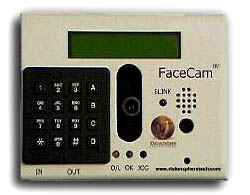 |
| FaceCam is a biometric product
made by Ottawa's VisionSphere Technologies. |
It's one in a growing list of Canadian
companies that have jumped on the biometrics bandwagon.
Until a few years ago it was mainly the
stuff of movies, but biometrics – the science
of automatically identifying people based on unique
traits – has rapidly become commonplace. Machines
that can I.D. a person from their face, fingerprints
or eyes, are scanning away in businesses, homes and
airports.
Biometrics has been around for centuries
in low-tech forms. But since September 11, 2001, new
biometric technologies has left the lab and entered
everyday life.
Old idea, new technology
The Chinese figured out how to tell babies
apart by making ink impressions of their feet 700 years
ago. Europe didn’t develop fingerprinting until
Scotland Yard began using it in the early 1900s. Modern
technologies like iris and face recognition began popping
up in the 1980s. But it took the disaster of 9/11 to
bring biometrics to the forefront.
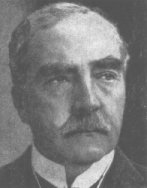 |
| Sir Edward Henry created
the first fingerprinting system in 1900 for Scotland
Yard . |
After the attacks, the U.S. passed laws
like the Patriot Act, and the Aviation and Transportation
Security Act, which mandated the use of biometrics as
a tool to find and stop terrorists and criminals.
Hi-tech companies got in on the act quickly.
By 2002 the global biometrics industry was worth about
$600 million. This year it took in $1.4 billion, and
it is projected to reach $4 billion by 2007.
Today, elementary school kids in Pennsylvania
buy lunch with automated fingerprint scanners that deduct
money from their accounts and the state of Florida books
criminal suspects into jails using facial recognition..
Canada has been slower to embrace biometrics
than our southern neighbour.
“We’re behind in many ways,
some of which are important, some of which aren’t,”
says Andy Adler, a biometrics researcher at the University
of Ottawa.
Adler, who cut his teeth developing scanners
and encryption software for biometrics companies, is
a supporter of the technology, but admits not every
application is worthwhile.
“Biometrics for school lunches is
stupid,” he says. “It costs far more to
put in a fingerprint system than it does to just deal
with the fact that the occasional student will take
an extra lunch.”
| 'I’m a firm
believer that biometrics is a good thing for governments
to keep. There’s bad people out there and
we need to use the technological tools we can to
try to find them.' |
Where it’s worth the expense –
like restricting access to a company’s computer
network, or preventing terrorists from crossing the
border - Adler says biometrics can play a key role.
“I’m a firm believer that
biometrics is a good thing for governments to keep,”
he says. “There’s bad people out there and
we need to use the technological tools we can to try
to find them.”
The Canadian government is starting to
get that message, thanks in part to a push from the
south. One American stipulation after 9/11 was that
countries whose citizens didn’t require visas
to enter the U.S. must now develop passports with biometric
information to maintain that status.
Canada’s passport office
has not made that change yet, but in 2003 it completed
a pilot study of facial recognition, which according
to the office’s website, “definitely confirmed
the value” of the technology. And the same year,
new passport photo requirements made smiles, bad lighting
and fuzzy focus verboten: those factors reduce
the ability of a machine to ‘read’ the photo.
Matching mug shots
Some law enforcement
agencies have been quicker off the mark. The Canadian
Police Research Centre began a project in 2002 to implement
facial recognition in the booking process.
Project BlueBear, which used VisionSphere’s
technology, lets police match suspects with mug shot
databases from multiple police departments.
Andrew Brewin, CEO of BlueBlear Networks
International, a law-enforcement spin-off of VisionSphere,
says the project was a success, and the company is working
on commercializing the technology.
Brewin says BlueBear uses facial recognition
because unlike other biometrics, it can make use of
the large photo databases that already exist.
“Being able to make use of those
mug shots and other facial databases and obtaining pictures
of people is an awful lot easier than getting their
fingerprints,” says Brewin.
He says that if his technology has been
in use in U.S. airports, at least one 9/11 hijacker
would have been identified and stopped.
Facial recognition is one of the big
three biometrics in wide use, beside iris and fingerprint
systems.
All three operate on the same principles.
First, an image of some feature unique to an individual
is captured. This could be the ridges and folds of a
fingerprint, the patterns of the iris, or certain facial
features like the distance between eyes.
Once the features are captured, they
are converted to digitally encoded templates, and stored
in large databases on computers that, at least in theory,
are secure.
When a person wants entry to a restricted
area, or access to a computer, he allows a scan of whatever
feature is needed. That digital template is then matched
to the existing database to verify if that person is
who he says he is, or whether or not he is on the list.
Biometrics finding everyday uses
Seemingly mundane uses for biometrics
are becoming more and more popular. IBM laptops allow
people to log on without worrying about passwords or
codes; some Japanese cell phones are equipped with fingerprint
scanners to deter phone theft.
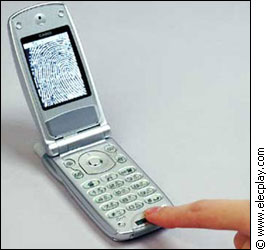 |
| In Japan, some cell phone
are equipped with fingerprint scanners to deter
thieves. |
Fingerprint scanners come in two varieties:
optical scanners, which work by the same principles
as digital cameras, and capacitance scanners which use
electrical currents.
With optical scanners, the subject places
their finger on a glass plate, while a digital camera
with a light source shines light on the print, and photoceptors
measure the reflected light. A negative image is obtained,
with dark lines representing the ridges and light lines
representing the valleys of the print.
Capacitance technology uses a semiconductor
chip with many tiny pairs of conductor plates. Each
pair can detect how far the conductive skin of the finger
is from the plates as a difference in capacitance. This
way it can tell a ridge from a valley and convert this
into a detailed fingerprint image. Unlike optical scanners,
capacitance requires a real three-dimensional fingerprint,
and cannot easily be fooled by a photo.
Facial recognition really just requires
a camera and software.
BlueBear’s Brewin says that facial
biometrics is popular because it is up to 10 times cheaper
than fingerprint technology with its expensive scanners.
A facial recognition system uses a high
definition camera which adjusts itself to center on
the face, while the computer searches for pre-designated
features. Hard tissues like eye sockets, the bridge
of the nose and the jaw are used because they are difficult
to alter, even with plastic surgery.
Those features, called nodal points,
are measured by the system and converted into a numeric
code called a faceprint, which can be matched with other
faceprints in a database.
Some facial recognition systems are able
to work from a distance, using surveillance cameras,
or even photographs – unlike iris and fingerprint
scanning which require a subject to submit to a scan.
With accuracy rates around 92 per cent,
face recognition is probably not good enough for the
highest security uses. But Brewin says his labs are
working on the latest development – 3D facial
scanning – which he contends will revolutionize
the industry.
3-D revolution?
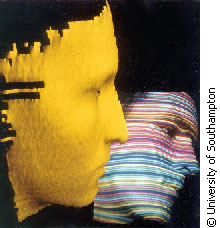 |
| New 3D biometrics offers
the potential of higher accuracy. |
The 3-D system uses pairs of closely-spaced
cameras to record different angles of a face. Millions
of tiny visual features are captured from every angle
and triangulated or processed to determine the distance
of each from the cameras. Computer algorithms, a set
of binary instructions, “connect the dots”
to render a three-dimensional model of the face, which
can also be called up by a human operator to verify
who is standing in front of them.
Ideally, 3-D technology would increase
accuracy, but researcher Adler is unconvinced of the
merits of 3-D and other new biometric technologies.
“New is not necessarily better,”
he says. “New is suspicious.” But he adds
that these unproven technologies will find homes in
places like retail stores, where novelty trumps reliability.
The third major biometric in wide use
is iris scanning. Considered one of the most accurate
technologies, iris scanners can identify up to 266 unique
features — almost triple the fingerprint standard
of 90.
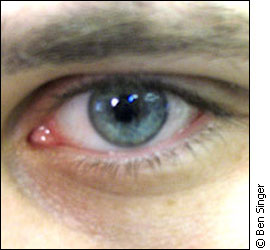 |
| The striations and patterns
of the iris are a powerful biometric identifier.
|
Iris scanners take a black and white picture
of the eye from up to a metre away, using a non-harmful
near-infrared light.
Algorithms determine the boundaries of
the iris, and through a process called demodulation,
converts the unique iris features into a digital code
that can be stored and compared with others.
Air passengers can see iris scanning
at work in some Canadian airports, under the CANPASS-Air
program. The Canadian Border Services Agency program
allows people to sign up for a fee, and after a background
check they can have their irises scanned. When returning
from out of the country, CANPASS members simply look
into a scanning kiosk, and once verified, skip through
customs without waiting in line.
The accuracy of iris biometrics means
the number falsely accepted will be almost zero, but
Adler points out that the technology may falsely reject
some people who are in the database.
Spoofing the scanners
Despite the increased presence of biometrics,
the integrity of the technology has been questioned
by “Black Hat” researchers, who have shown
how to ‘spoof’ or trick scanners with photos,
videos or – in one famous case – fake fingers
made of gummy bear material.
For this reason, many companies now incorporate
‘liveness detection’ into their systems.
“One of the things we do is we make
sure there is some movement when we’re taking
the picture, so we know it’s a person –
there’s somebody real in front of the camera,”
says Brewin. “But you could still use an LCD screen,
for example, to trick it.”
Other liveness detection methods include
fingerprint sensors that measure blood oxygen levels,
or look for a pulse, but few are that ambitious.
Rene McIver, director of technology at
Bioscrypt in Mississauga, says the company’s fingerprint
technology is immune to some attacks, but it’s
not spoof-proof.
“Your finger has conductive properties
to make (scanning) happen,” she says. “Not
all materials have that property, and so you would have
to make sure that the material that you were using to
create a fake finger would have that property for this
particular sensor.”
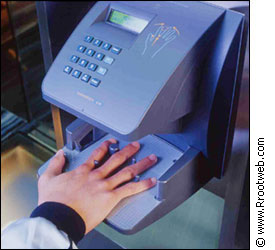 |
| Hand scanners are appearing
in offices and stores, for employees to sign in. |
Bioscrypt has contracts with the Canadian
Aviation and Transportation Security Association and
the U.S. Dept. of Homeland Security.
McIver says the key to the company’s
success is the software they use to match prints to
a database.
Unlike most programs which reduce the
fingerprint image to a set of defined ‘minutiae’
– like ends or bifurcations in ridges –
Bioscrypt’s pattern algorithm reads the whole
fingerprint.
McIver proudly boasts that Bioscrypt’s
algorithm won first prize at the Fingerprint Verification
Competition in 2002 and 2004, outperforming all other
industry and academic players.
| 'I’m pointing
out there are flaws in the encryption strategies,
and it’s possible to get information out of
these systems that you might not think are possible.' |
But some researchers caution that
using entire patterns – instead of discrete minutiae
– could allow a hacker with time and dedication
to recreate the print. Andy Adler recently demonstrated
this in facial recognition. Using a technique called
‘hill climbing,’ Adler reconstructed key
features of a face in reverse from a digital database.
This, despite some developers’ insistence that
it was impossible.
Adler is cautious about his findings,
saying, “I haven’t by any means pointed
out that these things don’t work, or that they’re
really wide open.
“What I am concerned about is there’s
very little researchers like me who are looking for
the problems . . . I’m pointing out there are
flaws in the encryption strategies, and it’s possible
to get information out of these systems that you might
not think are possible.”
McIver, who works with Adler on standardizing
the biometric industry, says that Bioscrypt is developing
new encryption techniques to prevent abuse or theft
of people’s information. But she adds that people’s
concerns about protecting something as easily available
as their fingerprints may be misguided, asking, “Why
would we try to hide that unnecessarily, when you can
go and grab it off a glass?”
Nowhere left to hide?
While Adler and McIver see biometrics'
benefits — from security to convenience —
some question its increasing use.
Organizations like the American Civil
Liberties Union cried foul when it was revealed that
police used facial recognition surveillance systems
to scan fans at the 2001 Super Bowl.
In Canada, concerns have been raised over
the potential use of biometrics in identity cards for
immigrants and refugees.
Ian Kerr, a law professor at the University
of Ottawa, says racial profiling and invasion of privacy
are issues that should be discussed when making the
decision to use biometrics.
"The use of biometrics is just one
more example of what has seemingly become a kind of
fetish practically, for identifying people for all sorts
of things,” Kerr says.
“The real question to ask is what
is the purpose to identify and sometimes we build a
sort of false sense of security around the need to identify
people, but really, many of those technologies lead
to all kinds of ill consequences.”
Brewin, CEO of BlueBear, says he is concerned
about privacy issues, “both as a Canadian and
as a businessperson.” He defends his company’s
law enforcement products, which he says provide, “the
ability for the individual police departments that own
the data to ultimately control who sees it, and what’s
allowed to be seen of it.”
And while Adler is concerned about abuses
of biometrics, he doesn’t see the technology as
the culprit.
“The issue is that the governments
aren’t trustworthy with the data,” he says.
“The biometrics of lack of it isn’t going
to stop that core privacy invasion issue.
“I’m concerned about it, but
I don’t actually see biometrics as the core evil
here.”
|